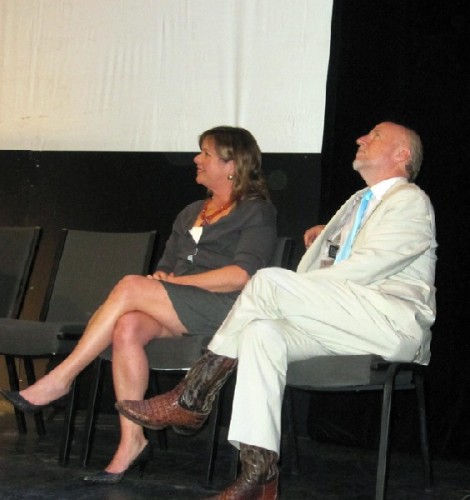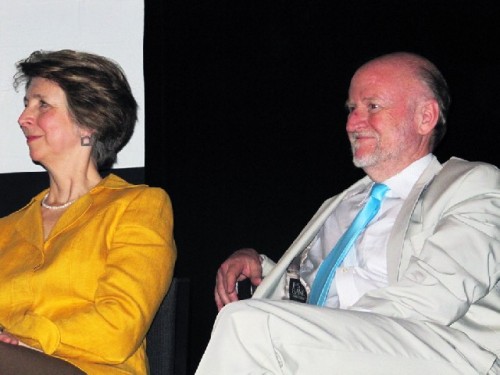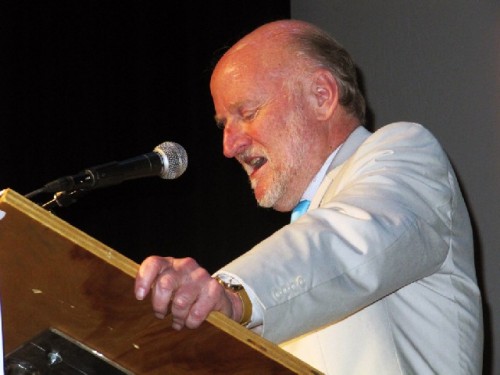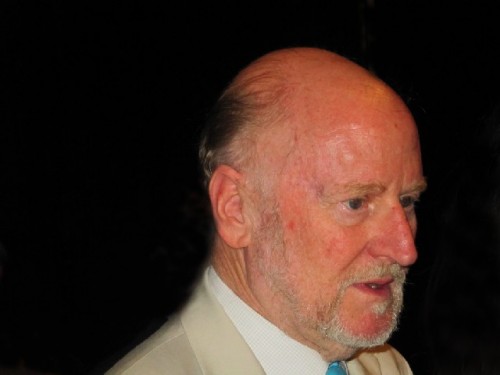NEA Head Rocco Landesmann's Our Town
Describes New Initiative in Mass MoCA Speech
By: Rocco Landesmann - May 24, 2011
It is so great to be here in the Berkshires, for my first time as NEA Chairman. Since arriving at the agency back in 2009, I have been talking about “creative placemaking.” Inevitably, the very first example that comes up is the Berkshires and the relationship between Mass MOCA and North Adams.
Creative placemaking is, fundamentally, the ways that cities and towns use the arts and other creative assets to shape their social, physical, and economic characters. And North Adams is really the best example of how that can work.
In this day and age, art is one of the few things that has to be consumed in person, in place, and in real time. Most art is place-based. Think about the typical artist’s bio, which begins: “Jane Doe lives and works in…” We believe that place informs art. It’s like the French concept of “terroir,” where the grapes for wine reflect the unique geography, geology, and micro-climate for the area in which they were grown. In the same way, the best art reflects its unique local influences.
There is a wonderful organization called Worm Farm that has coined the term “cultureshed” to refer to “a geographic region irrigated by streams of local talent and fed by deep pools of human and natural history; an area nourished by what is cultivated locally.” I like that, and I think it is a vital concept for any of us who care about the future of the arts. In fact, I was greatly heartened to read a quote from Rebecca Blunk that began, “Though the creative economy movement is global, we know that success really happens locally.” As usual, Rebecca is exactly right.
Back in January, I participated in a convening at Arena Stage in D.C., and I talked about what I fear is the homogenization of theater in this county. (I also talked about the supply of and demand for arts organizations in this country, which were the comments that got much more attention.)
But I want to go back to the homogenization of culture conversation, as I think that is an equally important conversation to have. Why is it happening?
Let me take theater as my example because it is the art form I know best. Too many artistic directors in this country are defining success as a combination of three things: attendance (or “butts in seats” as we producers are fond of calling it), income, and national attention.
The easiest way to achieve those three elements is for theaters to reorient themselves to look toward Broadway. If a theater is producing a show that has been on or is headed to Broadway, they can count on robust ticket sales, some sort of commercial subsidy for producing the show, and perhaps a review in The New York Times.
But what is the result of defining success that way? Too many resident theaters across this country whose seasons are interchangeable. The plays that are being presented bear no relationship to their locality. A notable exception to this is Trinity Rep in Providence, which follows NEFA’s lead and is defining success locally. The actors in residence at Trinity Rep do not want to make it to Broadway—in fact, many of them worked to get off Broadway, in order to get to Trinity Rep.
The Trinity actors with whom I have spoken are interested in being artists, but they are also interested in being citizens of a place and being part of a community. At the NEA, we want to encourage this, so we are calling for two things to happen simultaneously: we need artists to invest in the places where they live, and we need those places to invest in their artists. I came to the Creative Communities Exchange today because I believe we share a belief in projects that are specific, local, and successful.
The Knight Foundation recently released their Soul of the Community report, for which Gallup polled communities to discover the factors that create a sense of attachment between people and place. The top three findings? Not the economy. Not schools. Not safe streets. Of course, those are all important factors in choosing a place to live. But they are not what make someone love living there.
The three drivers of attachment—the three things that make someone love their community—are social offerings, openness, and aesthetics; three things that are the hallmark of the arts.
Besides a sense of attachment, if we turn to the work of researchers at the University of Pennsylvania, we find some other key things that come along with a robust arts community. Mark Stern and his colleagues have done longitudinal research on Philadelphia and Baltimore and discovered that the arts bring with them three primary benefits to communities. One: the arts are a force for social cohesion and civic engagement. In communities with a strong cultural presence, people are much more likely to engage in civic activities beyond the arts. Community participation increases measurably, and the result is more stable neighborhoods. Two: the arts make a major difference in child welfare. Income groups with high cultural participation were more than twice as likely to have low truancy and delinquency rates. And three: art is a poverty fighter. Artists form clusters. Cultural institutions spring up near them. People gravitate there. Businesses follow people. Businesses hire, and a vigorous local economy is born. Just look at the Berkshires.
This is some pretty powerful stuff: art creates community attachment. It increases civic engagement and child welfare. And it fights poverty while driving local economies. Wow. So why isn’t everyone just wildly investing in the arts?
I think some of the problem comes from the arts community itself. Members of the arts community—in many ways, rightly so—consider ourselves to be extremely special, and to be different and apart from the rest of society.
There is a very positive aspect to this. At Columbia University, Joan Jeffri did a study of aging visual artists and discovered that “artist” is a master identity that transcends race, gender, class, and age. As a result, aging artists have larger social networks with far more intergenerational contacts. Artists affiliate with other artists. They recognize themselves in one another and want to be connected. As they find each other, they build communities, neighborhoods, organizations, and businesses.
In many ways, New York City’s SoHo neighborhood is the textbook example of this. It is a great and powerful redevelopment story, but it is one that is colored by gentrification. Why? Because the flip side of artists feeling “special” and apart is that they often do not see themselves as having anything in common with the other citizens who live in a city or town.
Take the issue of artist housing. Many artists talk about artist live-work space as a right that comes with the “specialness” of the artist. But I don’t need to build housing for Jasper Johns or Tony Kushner, thank you. Both are pretty special, but I believe that we need to build artist housing because artists are an often low-income sector of the workforce and receive a majority of their income as independent contractors. They need subsidized housing alongside other low-income, temporary, and self-employed workers.
But we do not affiliate with other low-income citizens because we too often see ourselves as separate and apart. As one colleague put it, “Artists are like, ‘Yeah, I may be poor, but I am not poor like you.’”
But that is not happening here. Throughout New England, I have met artists who conceive of themselves as citizens. They are citizens with a pretty special job to do: to make and present art. They are also citizens with a larger, community responsibility to the area.
That impulse, that notion of “artist-citizens,” is what led me to propose $5 million of new funding at the NEA called “Our Town.” It’s called “Our Town,” frankly, because that’s a play, I am a theater guy, and getting to name things is pretty much the only prerogative of being chairman. But it’s also called “Our Town” to highlight this place-based aspect that I keep coming back to. We piloted this sort of work through a series of grants we made in conjunction with the NEA’s Mayors’ Institute on City Design, which has worked with mayors for the past 25 years.
But let me give you an example from another part of this country. In Shreveport, Louisiana, the regional arts council’s offices were burned down in a fire set by an arsonist. Shreveport’s mayor stood by the arts council and promised them that they would not just rebuild, but that they would rebuild something even better.
And the mayor delivered. In a twist worthy of O. Henry, the mayor gave the arts council a beautiful historic building for their new home, a historic building that had actually been Shreveport’s firehouse. The space was provided by the city for free, and the NEA provided the first $100,000 toward the design costs for this adaptive reuse project. On top of that, Shreveport received $300,000 from a national foundation that had never before invested in Shreveport. Shreveport then took the NEA’s $100,000 and the foundation’s $300,000 and leveraged it into raising $5.3 million for this project.
The project is itself fabulous, and the building will also be the center of a seven-block creative commons that will have rehearsal and studio space, performance and gallery space, artist housing, businesses, restaurants, and community services. I spent much of the day with the mayor, and he was constantly pointing to abandoned buildings that were in the process of being repurposed for the arts.
I bring up Shreveport because the project is great evidence that the success we have seen in North Adams is replicable. The details are different—they are locally-specific—but the overall theme is the same. In these cases, abandoned space was not an intractable problem. It was an opportunity, ripe with possibility. Communities did not look at artists as interlopers, or as a needy constituency; they looked at them as a vital part of the community who bring with them creativity, innovation, and vitality.
You have powerful advocates in the New England Foundation for the Arts, and their Creative Economy Initiative—and especially their new definition for the creative economy—is vitally important in knitting together the arts with the rest of society.
I am so glad to be with all of you today, and I look forward to even more conversations this afternoon. As I am fond of saying, “art works!”
Thanks so much.
Questions and Answers
Question New England is well represented in the power structure of Congress. Senator Lahey of Vermont. Senator Reeve of Rhode Island. The list goes on.
Rocco Landesmann Especially in Rhode Island. Senator Whitehouse.
Q I don’t want to take all of your time particularly with the small state of Rhode Island. Is there anything we can do to advance your message with our representatives? It seems the stronger we make our positions with our representatives the stronger the position in a very difficult environment.
RL Yes, as I said in my speech, behave like a constituency. Which artists don’t tend to like to do. There are throughout the country 5.7 million arts related jobs. That’s a very powerful constituency and I think you have to have more gatherings like this. Where you talk together and come together and start to speak with one voice. Politically that has a very powerful effect in my opinion. Senators Whitehouse and Reeve of Rhode Island are effective because they know they are representing an arts state and their constituency reminds them of that all the time and that’s what we have to do everywhere.
Q Hi. I’m Jean McGuiness from the Maine Center of Creativity.
RL I love Maine.
Q We have a project called Art All Around and it is intended to be full of puns. We are transforming a bunch of oil tanks in the port of Portland into the world’s largest public art painting. In terms of working in this field what happens to all of the wonderful facts and information that you share that are involved in economic development and rejuvenation of communities? What are the strategies for getting the money that is needed in this area? How do we get this money, billions upon billions of dollars, to invest in this area? So that all of the areas in the Unites States can be rejuvenated. Do you have some thoughts on that area?
RD We have to collect the data to make the change. One of the things we are doing with Our Town is collecting the data to show what a difference this makes. There is also a lot of research that has already been done and I cited some. The University of Pennsylvania researchers, Mark Stern, Susan Sypher, and we can do a lot more. At the NEA we need a national platform to do a better job of collecting and organizing that material so people can have it. To make a better case throughout the country and that is one of the very important things to do in the next couple of years.
Don Burton Can you tell us more about Our Town and how it works?
RL I think about it in the most general terms as the intersection of the arts and the real world. Those aspects of the arts that are going to deal with people’s almost daily lives. In most cities and towns that most often has to do with public art. The elements of design and planning in the communities. Arts festivals. Architecture. All of the aesthetic aspects of public art of all kinds. The points where people engage public art almost not even knowing it. A part that has a design or aesthetic to it or a public art performance. An arts festival or public art sculpture garden. Things that may actually intersect with people’s lives. It is a part of the revitalization of a community so it is very broad. We are not talking in Our Town about more money for the great and august temples on the hill. The great theatres, symphonies and museums that are a bit daunting and forbidding for a lot of people. We’re talking about a middle section that touches people’s lives and that’s what we are talking about in Our Town. Another part of that, since we’re here (Mass MoCA), is the creative reuse of structures. That’s a big part of Our Town.
Helena Fruscio About a month ago I was at a retreat and somebody asked why do you call yourselves Berkshire Creative.? Why does anyone care? What about the creative economy makes you really engage with them? I go to other places and realize the chamber doesn’t really work with the creative economy. So I ask why would we do that here? Is there anything on the national level that are pushing people to make these sort of connections? I know you recently did a collaboration with HUD. So what else do we do to get into economic development? Because so often I walk into artists that are out there in an artist creative thing and I start to talk to them and make the discussion around the creative community. Is there anything happening on the national level in the chamber? And other departments? In some ways it just seems that it is something to wrestle with. I was just wondering if there is anything that…
RL Restructuring is one of the main things we are doing. I have been knocking on the door of every cabinet secretary that has anything to do with the arts. Because that’s where the money is. Famously they asked Willie Sutton why he robbed banks. And he said because that’s where the money is. So that’s why I’m involving HUD and the Department of Transportation, the Department of Agriculture, and the Department of Education. HUD put out $100 million in which grants were made to arts organizations. This was a huge step for the NEA. It’s new territory for us. One of those grants was made here for Greenfield, Massachusetts. We want to do a lot more of that. The Department of Transportation is no longer just about engineering and road building. At HUD Ray and I have had many discussions about how to work together. The Department of Education in its Promise Neighborhoods program has put in the arts as a part of the evaluation. We are doing that across the board and are very excited about this. You folks, when you are putting together grant proposals, have to think broadly about federal agencies. Not just the NEA, to collaborate and come together to do significant work. Because they have a lot more money than we do and we all know that.
Q I’m thinking about industrial spaces that are reconverted to the arts and the kinds of jobs they generate. In our community the zoning has changed. Is there any discussion on a national level about industry and jobs in the preservation of industrial spaces for the arts?
RL Yes and that is one of the most important conversations we can have. In Providence the work is being done with the old steelworks. Not necessarily for a new purpose but to connect to the old purpose it used to have with metal fabrication. I toured recently the Michigan Union Station in Detroit which is an amazing building. One of the most impressive buildings aesthetically I can ever imagine. Right now it’s in total ruin. But if it can be rebuilt it could jump start the entire neighborhood of Detroit. This is something we have started to talk to the other agencies about. It is one of those conversations that I think is critically important.







